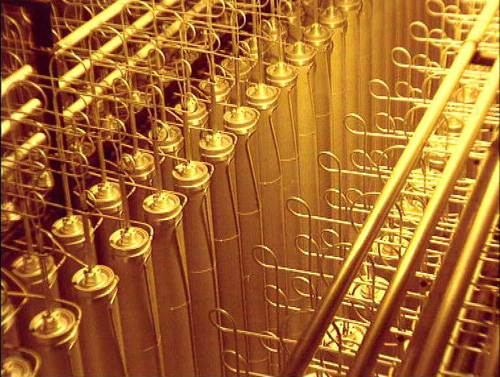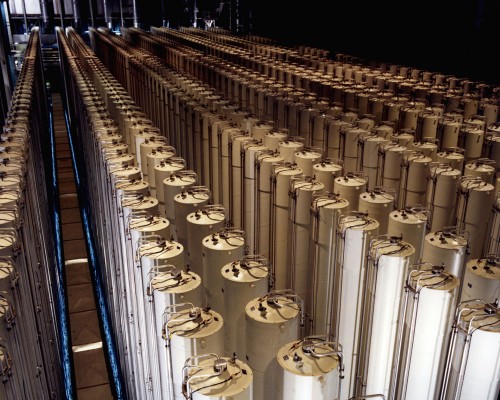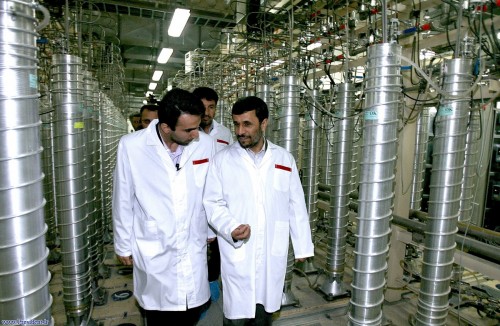I wrote about centrifuges a few weeks ago, and have learned some new, interesting things since then. John Krige, a professor at the History, Technology, and Society program at Georgia Tech, has two quite provocative articles published about interactions between the US and the UK regarding centrifuges in the mid-to-late 1960s. They are worth your attention.
Krige’s first article is “Hybrid knowledge: the transnational co-production of the gas centrifuge for uranium enrichment in the 1960s,” just published online (and forthcoming in print, I believe) in the British Journal for the History of Science (BJHS).1 As the title may tip you off, this is an article for a primarily history of science/science studies crowd, and speaks in that idiom. Don’t let the jargon scare you off, though: as far as the genre goes, it’s readable and the underlying point is an important one. It concerns the interchanges of centrifuge information between the US and the UK in the early 1960s, which were done under the 1955 US/UK Agreement for Co-operation on the Civil Uses of Atomic Energy, and their consequences when the UK, Netherlands, and Germany decided to go into a cooperative, profitable effort to produce a commercial centrifuge enrichment plant in 1967. (What eventually became URENCO, I believe.)
The US thought this was a somewhat dodgy enterprise — they really didn’t think centrifuges would be as profitable as gaseous diffusion, their chosen enrichment method, but the UK disagreed — but were happy to support it, so long as the UK didn’t give away any “restricted data” that had been produced by the US. And there’s the rub: the UK and US had been exchanging information for a long time, and the UK really thought that it had produced a completely indigenous design (taking off from Gernot Zippe’s unclassified contributions) without any significant US “data” in it. The US disagreed and threatened to cut off all future US-UK exchanges if the latter didn’t let them verify to their satisfaction that there wasn’t any US data in the design. The UK, for its part, thought that it had a really superior centrifuge design compared to the US, and were worried that if the US claimed parts of it were “theirs,” it would completely muddy up their attempts to get clear of the US monopoly on the enrichment of uranium.
In the end, the US decided the UK design was kosher enough, and all was well with them. But it’s a fascinating (and to me, totally unknown) episode in the US-UK “special (nuclear) relationship,” one which really highlights some fundamentally interesting aspects of both US and UK atomic policy, and the fundamentally transnational (as Krige puts it) nature of modern centrifuge development (an Austrian working in the USSR develops technology that he then further works on in the US and the UK which is then turned into a company with the UK, Germany, and Netherlands, etc.). It also gets into some good history of science questions about how one identifies the source of any given piece of design or machinery — and how difficult that can be.
The second paper by John is “The Proliferation Risks of Gas Centrifuge Enrichment at the Dawn of the NPT: Shedding Light on the Negotiating History,” just published online (and imminently forthcoming in print) in The Nonproliferation Review.2 This essay was a winner of an annual prize by the journal (one of two) and John gave a presentation on it last Thursday at GWU (which you can watch online — John is the first of the two speakers/winners, after the introduction by Stephen Schwartz).
In this paper, John tackles the question of the apparent ambiguity in the 1968 Nuclear Non-Proliferation Treaty (NPT) about whether centrifuge-style enrichment activities (like that currently pursued by Iran) were considered a protected form of “peaceful use” to be allowed and encouraged. It has been speculated that at the time of the treaty’s writing, the risks posed by centrifuge enrichment — which is a lot smaller scale than gaseous diffusion plants, and thus easier to hide or protect — weren’t considered by the NPT drafters, and thus represent an unanticipated “loophole” in the treaty terms.
What John has found is that while centrifuges were not discussed in the official record, they were discussed extensively on the backchannel by the US and the UK. In particular, the UK was extremely worried about the proliferation potential for the gas centrifuge. They, after all, were pursuing the technology themselves, and knew it could be a potent game-changer in breaking the gaseous diffusion monopoly. They wondered if it would not be the angle pursued by a future proliferating state, and conveyed as much to the US.
The US was itself comparatively unworried. It thought that it (and its European allies) could control the spread of centrifuge technology through classification and export controls, and still were dubious that the centrifuge would play a bit role in world affairs anytime soon. I pushed John on this at the talk (you can hear me asking a rambling question about this at the 1:41:24 mark in the video linked above), and he elaborated in a way that I thought was more compelling: the US was weary about getting the treaty signed (they had finally gotten the Soviets on board, and the NPT treaty process was over a decade old at that point), and were worried that any attempt to modify the treaty at that point would bog it down for years to come. Furthermore, the UK was engaging in said partnership with the Dutch and the West Germans, and the US really wanted to make sure the Germans were still on board with the NPT.
(The West Germans were really not too pleased with the NPT and it was a huge hassle to get them to ratify it; like many nations, they appropriately saw it as an infringement on their national sovereignty and their future security options. Of course today the Germans are big supporters of the NPT — it’s interesting how these things switch around, depending on where you are sitting at the time.)
The UK didn’t push the matter, because it didn’t want to rankle the treaty process, either, and because it too wanted to profit off of the centrifuge. So both the US and UK let the matter slide. (I think John’s work highlights something that I’ve been thinking for a short while now: there’s a lot of potential for a “deep” history of the NPT, one that goes beyond the open record.)
Whether this affects one’s interpretations of the NPT today — John thinks that there is basically no real legal argument against Iran being able to develop centrifuges, and certainly no argument that the early NPT drafters had left an unanticipated “loophole” in place that anyone is taking advantage of — seems to me, someone not at all versed in international law, to be unclear. (Do off-the-record conversations between two parties count towards later interpretations of a treaty’s intent?) But either way, it’s a fascinating story. The apparent US lack of concern about specifically centrifuge proliferation has come back to haunt it, these decades later.
- John Krige, “Hybrid knowledge: the transnational co-production of the gas centrifuge for uranium enrichment in the 1960s,” BJHS (online May 2012). [
]
- John Krige, “The Proliferation Risks of Gas Centrifuge Enrichment at the Dawn of the NPT: Shedding Light on the Negotiating History,” The Nonproliferation Review 19, no. 2 (July 2012), 219-227. [
]






[…] discussed these Krige articles on US-UK centrifuge history in this post. […]